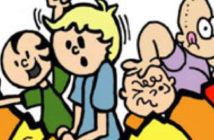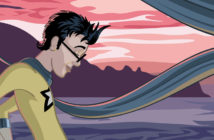Donna Stone is a magnetic character as the protagonist of Stone. She’s middle-aged, a little wide, and has a whole lot of moxie. Legend has it that she was once a great warrior, one that rivaled all other men, women, and monsters in the land. Or perhaps she was just a gifted mercenary. That’s the trouble with the nature of legends, isn’t it?
I wonder if Donna is what Xena would have been like had she endured years after her series came to a close. No, I don’t mean Lucy Lawless who played Xena: the actress’ recent appearance on the Starz Channel original series Spartacus: Blood and Sand tells a different story. But the Xena character—who knows.
Stone is a book that’s a little hard to place. Its genre is clear enough: it’s animated by the most classic of Tolkien-inspired, sword-and-sorcery fantasy on the market. The world is feudal. The rulers are corrupt. Towering demons roam the land. And there’s a rarely-spoken-of dark lord who only appears in second-hand stories.
But Stone has an innocent aura, like a newspaper comic strip. It reads more like Calvin & Hobbes than it does The X-Men, and that’s fine. Never forget that comic books are a medium, not a genre. It takes a wide array of stories to makes comics as a whole interesting and accessible for everyone.
The story of Stone is unadorned and humble, which seems to be the opening tactic for most fantasy tales. A band of women renegades stalk the streets outside the kingdom of Estaena until, of course, Donna Stone crosses their path. The vagrants are impressed by her strength of body and character, and they invite her to camp with them.
It quickly becomes clear that the women are trying to build a resistance, and who better to enlist than Donna, even if she is a little rough around the edges. This is what makes Stone deceitfully interesting. It accomplishes two subtle feats (no D&D pun intended): the first is that the protagonist of Donna Stone isn’t the typical heroine of a comic book. She’s getting on in her years, her body type isn’t what we assume to be the norm of a hero, and she’s completely dependent of any male influence. Unless, of course, you count all of the guys she thrashes around without a second’s glance.
The second is its passing of the Bechdel Test, which requires the following: a story has to have at least two women in it, and they have to talk about something other than a man. I don’t want to say that Stone is a feminist book, but it’s certainly open-minded in how it approaches its own story, and I find that refreshing.
As I already said, I enjoyed reading Stone because it reminded me of a newspaper comic strip. Comic books and strips are different disciplines, but they’re in the same family as far as I am concerned. Stone fits into both practices, what with its linear storytelling and simple (but exciting) black-and-white illustrations. It’s a book that made me happy, and that’s all I need sometimes.
This comic book review originally appeared on Broken Frontier.




